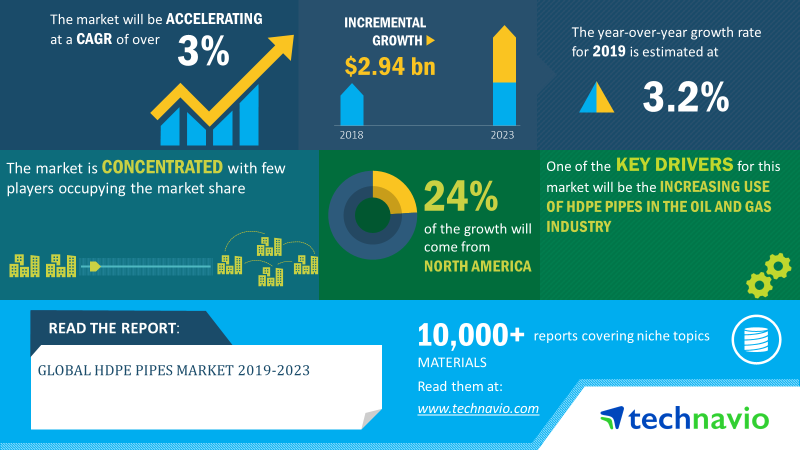Turn Your Global HDPE Pipes Market Into A High Performing Machine
The global HDPE pipes market size will grow by USD 2.94 billion during
2019-2023. This market report provides a detailed analysis of the market
by application (water supply, agricultural irrigation, sewage system,
oil and gas, and other applications) and geography (APAC, Europe, MEA,
North America, and South America). Also, the report analyzes the
market’s competitive landscape and offers information on many HDPE pipe
manufacturers, including Georg Fischer Ltd., IRPC Public Co. Ltd.,
LyondellBasell Industries Holdings BV, Polypipe Group Plc, and Uponor
Corp.
Key Insights on HDPE Pipes Market – Global Forecast 2019-2023

Major HDPE pipes market trends such as the increasing use of HDPE pipes in landfill applications will also influence market growth. Containment systems used in modern landfill sites use HDPE pipes because of their chemical compatibility and corrosion resistance. Larger and deeper modern landfill sites are generating high volumes of leachate, which is imposing a higher surcharge loading on underlying pipes. This has necessitated the need for designing better leachate collection systems. Hence, HDPE leachate collection pipes are used in these landfills that can withstand high pressures. As a result of these factors, the HDPE pipes market will register a CAGR of more than 3% during 2019-2023.
The report offers a detailed analysis of several leading HDPE pipe manufacturers, including:
Key Insights on HDPE Pipes Market – Global Forecast 2019-2023

Browse TOC and LoE with selected illustrations and example pages of HDPE pipes Market
Industry Overview
HDPE pipes are non-corrosive, leak-resistant, abrasion-resistant, and can withstand harsh chemical environment. They also cost less than steel pipes and require less maintenance. Because of such properties, the demand for HDPE pipes is growing significantly in the oil and gas industry. The industry specifically uses HDPE pipes in fracking operations to collect and transport oil, gas, and water from boreholes to the surface. Moreover, properties such as lightweight and flexibility make them ideal for oil and gas transportation. Over the past few years, the demand for HDPE pipes has increased across the oil and gas industry because of the growing awareness about the benefits of these pipes. The growing adoption of HDPE pipes in the oil and gas industry is one of the key factors that will boost the growth of the HDPE pipes market size.Major HDPE pipes market trends such as the increasing use of HDPE pipes in landfill applications will also influence market growth. Containment systems used in modern landfill sites use HDPE pipes because of their chemical compatibility and corrosion resistance. Larger and deeper modern landfill sites are generating high volumes of leachate, which is imposing a higher surcharge loading on underlying pipes. This has necessitated the need for designing better leachate collection systems. Hence, HDPE leachate collection pipes are used in these landfills that can withstand high pressures. As a result of these factors, the HDPE pipes market will register a CAGR of more than 3% during 2019-2023.
Top Companies in HDPE Pipes Market
The global market is concentrated. To help clients improve their market positions, this HDPE pipes market forecast report provides an analysis of the market’s competitive landscape and offers information on the products offered by various companies. This high density polyethylene pipes market report also includes information on the upcoming trends and challenges that will influence market growth. This will help companies create strategies to make the most of future growth opportunities.The report offers a detailed analysis of several leading HDPE pipe manufacturers, including:
- Georg Fischer Ltd.
- IRPC Public Co. Ltd.
- LyondellBasell Industries Holdings BV
- Polypipe Group Plc
- Uponor Corp.
Market Segmentation
HDPE Pipes Market by Application
- Water supply
- Agricultural irrigation
- Sewage system
- Oil and gas
- Other applications
HDPE Pipes Market by Region
- APAC
- Europe
- MEA
- North America
- South America
Comments
Post a Comment